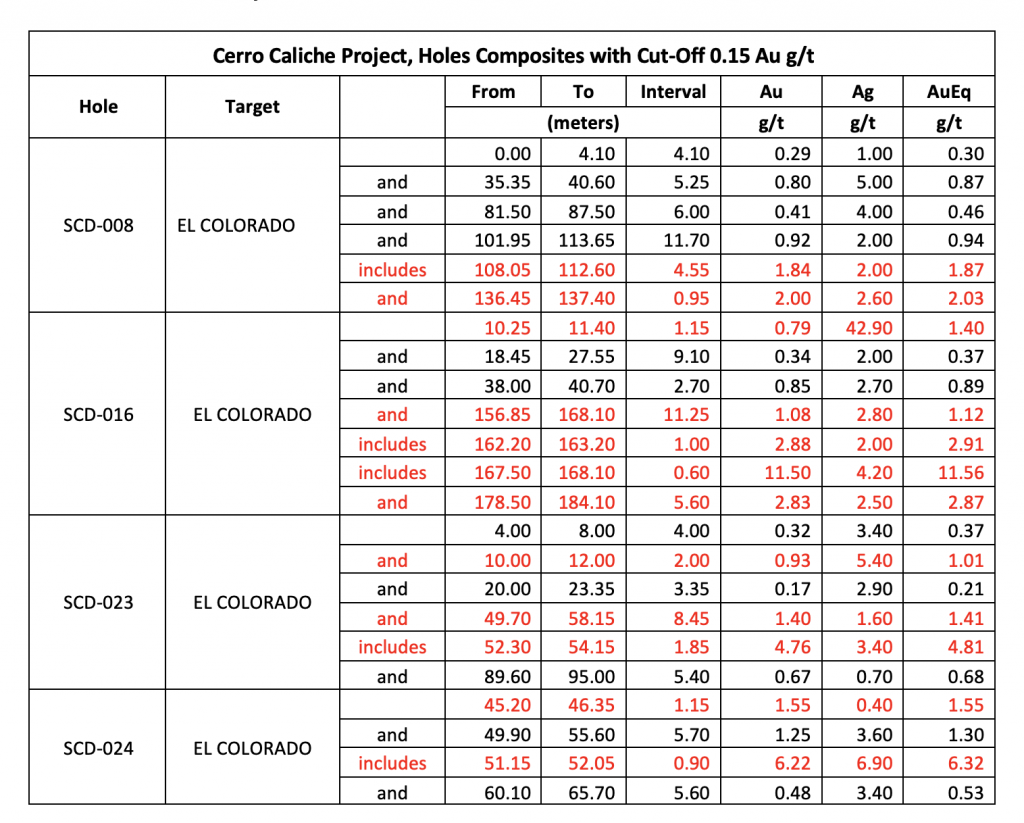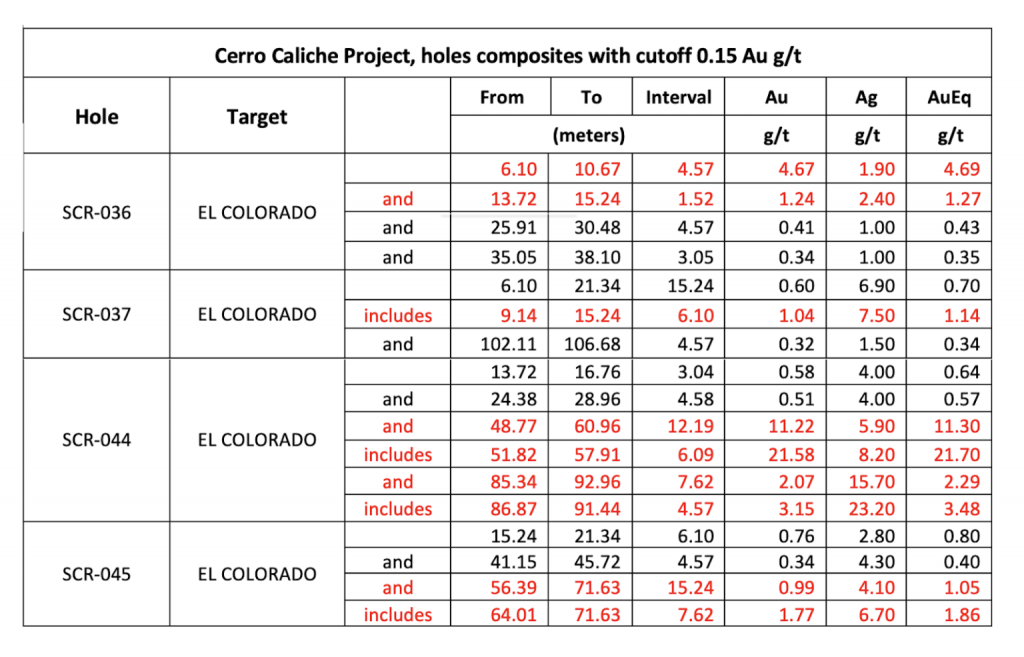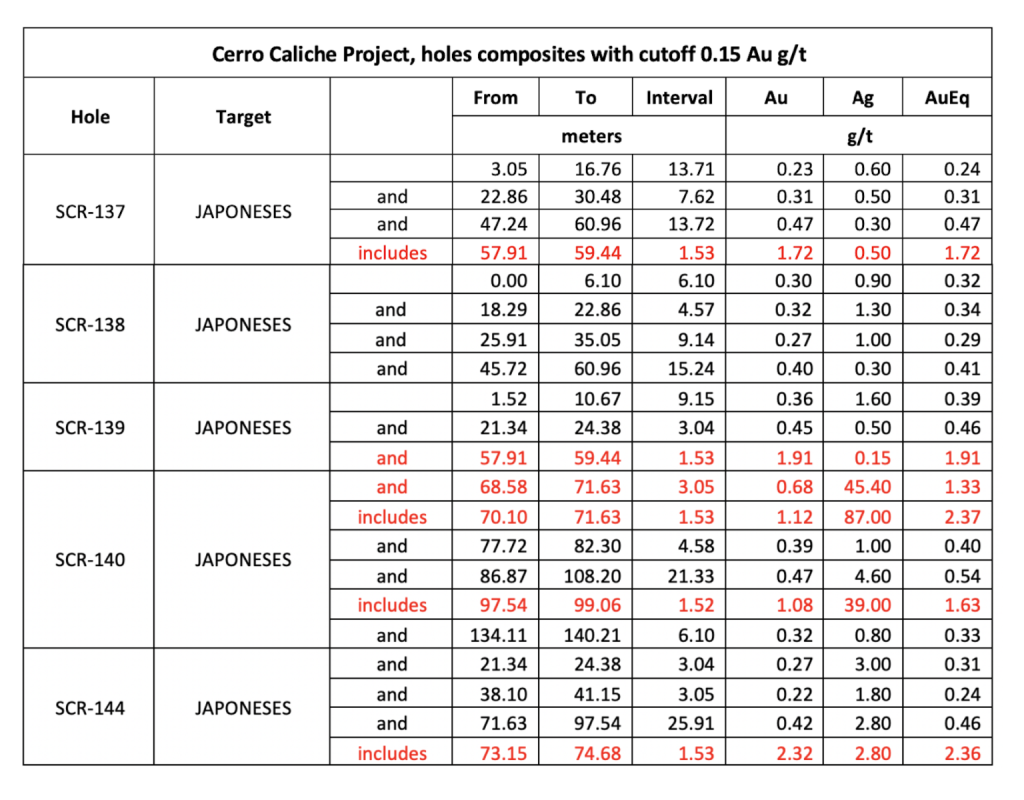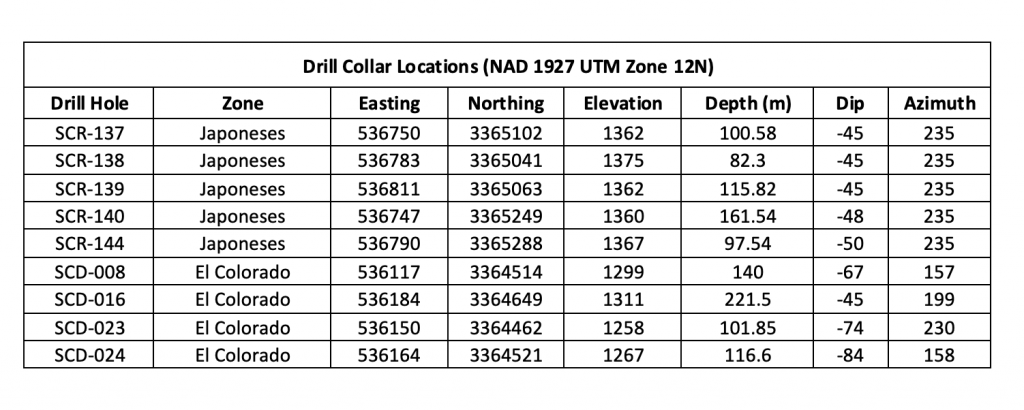VANCOUVER, Canada, December 18, 2020 – Sonoro Gold Corp. (TSXV: SGO | OTCQB: SMOFF | FRA: 23SP) (“Sonoro” or the “Company”) is pleased to report very favourable results from its current step-out and infill drilling programs. The current programs have demonstrated a material expansion of several mineralized zones, most notably at Japoneses, Buena Suerte, Veta de Oro, El Rincon and El Colorado (see map below). Based on these results, the Company is revising the parameters for a planned Preliminary Economic Assessment (PEA) to assess the viability of Heap Leach Mining Operation (HLMO) by increasing the target conceptual capacity from 8,000 tonnes per day (tpd) to 20,000 tpd.
On November 18, 2020, Sonoro reported engaging McClelland Laboratories of Sparks, Nevada to conduct independent metallurgical testing of the mineralization at Cerro Caliche for its upcoming NI 43-101 compliant mineral resource update and PEA based on all drilling results to December 15, 2020. Sonoro expects that this independent metallurgical testing will confirm and expand on the results of its preliminary in-house column leach tests.
As reported on December 8, 2020, and as a key component of fast-tracking the proposed Cerro Caliche mine development, Sonoro contracted D.E.N.M. Engineering Ltd. to prepare a NI 43-101 compliant PEA and Micon International Limited to prepare an NI 43-101 compliant updated resource estimate, based on all drill results up until December 15, 2020. The realization of the Company’s goal of commencing gold production by December 2021 remains dependent on several material conditions, most notably the satisfactory completion of the current metallurgical testing, a favourable PEA report, securing required environmental permitting and securing project financing.

El Colorado Zone – Assay results
Sonoro reports the following results from the current drilling program at El Colorado:
- SCD-008 intercepted 11.7 m averaging 0.92 g/t Au, including 4.55 m averaging 1.84 g/t Au,
- SCD-016 intercepted 11.25 m averaging 1.08 g/t Au including 1 m averaging 2.88 g/t Au,
- SCD-023 intercepted 8.45 m averaging 1.4 g/t Au, including 1.85 m averaging 4.76 g/t Au,
- SCD-024 intercepted 5.7 m averaging 1.25 g/t Au, including 0.9 m averaging 6.22 g/t Au.

Assays of four additional core holes at El Colorado are pending and will be reported in due course.
The El Colorado zone is located along an extensively mineralized east-west trending ridge in the southwestern part of the Cerro Caliche property. Drilling to date has outlined a gold mineralized zone approximately 300 meters long from north to south and 200 meters wide, which remains open to the northwest and southeast.
The cross-section image below of El Colorado demonstrates mineralization at relatively shallow depth due to the profile of the steep hillside in relation to the mineralization. Previously reported drill holes intercepted 12-meters averaging 11.22 g/t Au and 6-meters averaging 12.96 g/t Au.
Assays from four previous dill holes have been included in the cross-section for reference.
El Colorado Zone – Assay Results

Assay intervals of the four previously reported reverse circulation drill holes included in El Colorado cross-section illustration are tabulated below to provide context.

Continuation of the Core Drilling Program
Core drilling has been suspended until the New Year and is expected to recommence on January 4, 2021. A total of 24 HQ-sized holes were completed and assays for 11 of these holes are pending. An additional 11 PQ-sized core holes were drilled in the early part of the core drilling program specifically to supply mineralized material for metallurgical testing, essential to advance the Company’s plans to fast-track a proposed mine development program with a goal to achieve gold production by the end of 2021.
Japoneses Zone – Additional Results from Core and RC Drilling
At the Japoneses Zone, three core holes, SCD-001, SCD-002 and SCD-003, were completed to test for potential deeper extensions of the zone’s shallow epithermal mineralization. The targeted areas were about 200 meters lower than the zone’s drilled extent. The three 45-degree holes ranged from 370 to over 400 meters in length. SCD-001 intercepted 8 meters averaging 0.45 g/t Au beginning at 50.95 meters depth. SCD-OO2 encountered a wider interval of 21 meters averaging 0.41 g/t Au at 24.2 meters depth. These two reported intervals are in the upper part of the drill holes near the drill collars and they are part of the Chinos NW zone that extends the zone southeasterly by approximately 40 meters. SCD-003, which was collared at the northeastern-most extent of the Japoneses zone, was similar in trajectory and length to SCD-001 and SCD-002 and targeted conceptual deep high-grade gold vein systems which may have supplied the Japoneses shallow oxide gold mineralization. SCD-003 returned several narrow intervals of mineralization ranging from 0.212 to 0.978 g/t Au.
Assays from five additional RC drill holes from the Japoneses zone have been received. These drill holes, SCR-137 through SCR-140 and SCR-144, are important infill drill holes demonstrating continuous mineralization in gaps between prior drill holes.
Japoneses Zones- Assay Results

Drill collar locations, azimuths and dips for the drill holes included in this release are provided in the table below and have been posted to the Company’s website for all drill holes.

Core Drilling Program – Initial Assessment and Future Plans
The additional holes at the El Colorado zone have added to an already intensely mineralized zone, while drilling results in other known mineralized zones have allowed us to not only refine the epithermal model, but also importantly, where to search for future high-grade targets. These results have indicated that several of the initial targets, such as those previously reported at the Sultan zone near the eastern boundary of the property, were below the previously projected boiling zone in the epithermal system. Therefore, as the location of the ideal boiling zone has been shown to be at higher elevations, priority is now being given to already identified and potential high-grade targets, which are at higher elevations on Cerro Caliche. As these targets are much closer and, in some cases, adjacent to Cerro Caliche’s shallow gold mineralization, the higher grade would form part of an expanded near-surface resource estimate.
These additional results will enable Sonoro to further refine and develop its plans to test additional high-grade targets located at the higher elevations, while concurrently expanding the mineralized zones. Priority targets for the high-grade drilling program, which is scheduled to continue at least until April 2021, are at the Cerro Caliche peak, Buena Suerte, Cabeza Blanca north, in addition to El Colorado.
Melvin Herdrick, Sonoro’s Vice President Exploration, stated, “We are happy to conclude the year with strong results from the Cerro Caliche drill program enabling us to evaluate the possibility of a potentially larger mine operation than previously discussed. The latest results at El Colorado show it to be a well-mineralized block with numerous wide veins and veinlet zones all shown as a network, including two blind vein zones that may help define the structural setting of the geometry of the mineralization at Cerro Caliche. I am very optimistic with the potential for the El Colorado mineralized zone and how it could ultimately add to and better define Cerro Caliche’s planned resource estimate.”
Kenneth MacLeod, Sonoro’s President and CEO, added, “The Sonoro Board is grateful for the superlative efforts of our technical team in Mexico in expanding the known mineralized zones and defining new mineralized zones for quantifying in the upcoming NI 43-101 resource report. Special thanks go to VP Exploration, Melvin Herdrick; VP Operations, Jorge Diaz; and Chief Geologist, Oscar Gonzalez.”
John Darch, Sonoro’s Chairman, concluded, “It has been an exceptional year for Sonoro as we continue to advance our dual drilling program and meet important early-stage milestones towards our goal of achieving production. Our strategy of continuing to explore and develop Cerro Caliche’s extensive shallow oxide gold mineralization has been successful, while our fast-track program to test the viability of our proposed 20,000 tpd mining operation is on schedule. Most importantly, the recent drill results continue to exceed our expectations and support our decision to evaluate a material increase in the conceptual capacity of an initial mining operation. We believe this production decision will be welcomed by all shareholders.”
Results from Abel Zone
In the Abel Vein zone located in the eastern part of the property, a scout exploratory core drill hole, SCD‑017, was completed. This hole cut the vein structural zone with narrow intercepts of 0.3 to 0.33 g/t Au that are not considered significant. The Abel zone has similar geochemistry to the Sultan zone and, like the Sultan zone, is interpreted to be below the Cerro Caliche epithermal system’s ideal boiling zone.
Quality Assurance/Quality Control (“QA/QC”) Measures and Analytical Procedures
Drill samples are collected with an airstream cyclone and passed into a splitter that divides each sample into quarters. The quartered samples are then bagged and sealed with identification. The sample group has blanks, standards and duplicates inserted into the sample stream.
Bureau Veritas collects the samples and transports them directly to the preparation laboratory in Hermosillo, Sonora. At the laboratory, part of each sample is reduced through crushing, splitting and pulverization. About 200 grams are sent by BV to their Vancouver, BC laboratory and dissolved in aqua regia for multi-element ICP analysis including silver. Of these samples, 30 grams undergo fire assay in Hermosillo for gold by reducing the fire assay to a concentrated button of material that is dissolved in acids and the gold content determined by atomic absorption.
Some samples were collected by ALS-Chemex and transported directly to the preparation laboratory in Hermosillo, Sonora. At the laboratory, part of each sample is reduced through crushing, splitting and pulverization from which 200 grams is sent to the ALS-Chemex assay laboratory in Vancouver. Thirty grams undergoes fire assay for gold with the resulting concentrated button of material produced is dissolved in acids and the gold is determined by atomic absorption. Another quantity of the sample is dissolved in four acids for an ICP multi-element analysis.
No QA/QC issues were noted with the results received from either laboratory.
Geologic Description
Cerro Caliche is located 45 kilometers east southeast of Magdalena de Kino in the Cucurpe-Sonora Mega-district of Sonora, Mexico. Multiple historic underground mines were developed in the concession including Cabeza Blanca, Los Cuervos, Japoneses, Las Abejas, Boluditos, El Colorado, Veta de Oro and Espanola. Mineralization types of the Cucurpe-Sonora Mega-district include variants of epithermal low sulfidation veins and related mineralized dikes and associated volcanic domes. Local altered felsic dikes cut the mineralized meta-sedimentary rock units and may be associated with mineralization both in the dikes and meta-sedimentary rocks.
Host rocks include Jurassic-Cretaceous meta-sedimentary rock units including argillite, shale, quartzite, limestone, quartz pebble conglomerate and andesite. Younger intrusive rock consisting of medium coarse-grained granodiorite-granite is present in the westerly parts of the concessions near the historic Cabeza Blanca Mine. It is apparent that veining cuts and pervasively alters the intrusive stock. Rhyolite occurs in irregular bodies distributed in higher elevations in the northerly part of the concession, including the Rincon area, where it occurs as flows, sills, dikes and rhyolite domes. Part of the rhyolite is mineralized and appears to be related to epithermal gold mineralization throughout the property.
Qualified Person Statement
Stephen Kenwood, P.Geo., a Director of Sonoro, is a Qualified Person within the context of National Instrument 43-101 (NI 43-101) and has read and approved this news release. Readers are cautioned that the presence of mineralization on historic mines adjacent to or on Cerro Caliche is not necessarily indicative of gold mineralization in the concessions held by the Company.
About Sonoro Gold Corp.
Sonoro Gold Corp. is a publicly listed exploration and development company with a portfolio of exploration-stage precious metal properties in Sonora State, Mexico. The Company has highly experienced operational and management teams with proven track records for the discovery and development of natural resource deposits.
On behalf of the Board of SONORO METALS CORP.
Per: “Kenneth MacLeod”
Kenneth MacLeod
President & CEO
For further information, please contact:
Sonoro Metals Corp. – Tel: (604) 632-1764
Email: [email protected]
Forward-Looking Statement Cautions
This press release contains certain “forward-looking statements” within the meaning of Canadian securities legislation, relating to, among other things, the Company’s plans for the drilling of the above-described Cerro Caliche Concessions, located in the municipality of Cucurpe, Sonora, Mexico, and the Company’s future exploration and development plans for those properties, including statements regarding an anticipated increase in the current resource estimate for Cerro Caliche, a proposed 20,000 tonne per day HLMO, including a targeted December 2021 production start date, confirmation of the results of previous in-house column leach test results, the hoped for results of continued exploration drilling, including to test high-grade targets, and other material conditions set out above on which the Company’s development plans are dependent. Although the Company believes that such statements are reasonable based on current circumstances, it can give no assurance that such expectations will prove to be correct. Forward-looking statements are statements that are not historical facts; they are generally, but not always, identified by the words “expects,” “plans,” “anticipates,” “believes,” “intends,” “estimates,” “projects,” “aims,” “potential,” “goal,” “objective,” “prospective,” and similar expressions, or that events or conditions “will,” “would,” “may,” “can,” “could” or “should” occur, or are those statements, which, by their nature, refer to future events. The Company cautions that forward-looking statements are based on the beliefs, estimates and opinions of the Company’s management on the date the statements are made and they involve a number of risks and uncertainties, including the possibility of unfavourable exploration and leach test results, unfavourable results of the contemplated PEA of the Cerro Caliche project, the lack of sufficient future financing to carry out exploration and development plans, and unanticipated changes in the legal, regulatory and permitting requirements for the Company’s exploration programs. There can be no assurance that such statements will prove to be accurate, as actual results and future events could differ materially from those anticipated in such statements. Accordingly, readers should not place undue reliance on forward-looking statements. The Company disclaims any intention or obligation to update or revise any forward-looking statements, whether as a result of new information, future events or otherwise, except as required by law or the policies of the TSX Venture Exchange. Readers are encouraged to review the Company’s complete public disclosure record on SEDAR at www.sedar.com.
Neither the TSX Venture Exchange nor its Regulation Services Provider (as that term is defined in the policies of the TSX Venture Exchange) accept responsibility for the adequacy or accuracy of this release.
Original Article: https://sonorogold.com/news/sonoro-gold-to-evaluate-viability-of-a-20000-tpd-heap-leach-operation/























